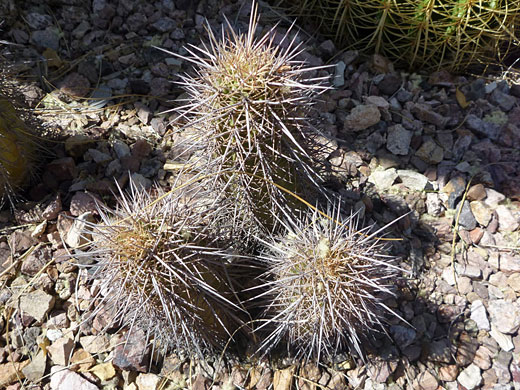Scientific name:
Echinocereus arizonicus
Common name:
Arizona claret-cup cactus, Arizona hedgehog cactus
Range:
Central and southeast Arizona, southwest New Mexico
Form:
Small cylinders; clump forming
Habitat:
Desert locations: grasslands, scrubland, limestone canyons, between 4,500 and 6,200 feet
Flowers:
Orange to red; yellowish at the center. Blooms in April and May

Distribution map for echinocereus arizonicus
Once considered a variety of echinocereus coccineus, echinocereus arizonicus is also very similar to echinocereus triglochidiatus, the main differences being the number of ribs (8 to 13 cf. 5 to 8), the number of central spines (1 to 8 cf. 0 to 4), and the shape of the spines; those of the former are genrally spherical in cross-section, with a smooth surface, while those of the latter are more ovate, and the surface is minutely bumpy.
Echinocereus arizonicus forms small clumps, with generally fewer heads than the two related species, and individual stems are slightly smaller, up to 15 inches tall and between 2 and 4 inches in diameter. Radial spines number between seven and 14, and are initially yellow to brown, becoming grey with age. Central spines are darker colored but also eventually become grey. Flowers have red or orange tepals, lighter at the base, orange filaments, pink to purplish anthers and green stigma lobes.
This species inhabits small areas of Arizona and New Mexico; the main region is approximately between Nogales and Lordsburg, while the plant is also found in the Superstition Mountains and the Mescal Mountains of central Arizona. Central spines number between one and four for specimens from these latter regions, but three to eight for the other populations. The similar echinocereus triglochidiatus is found further north; the regions do not overlap.
Echinocereus arizonicus forms small clumps, with generally fewer heads than the two related species, and individual stems are slightly smaller, up to 15 inches tall and between 2 and 4 inches in diameter. Radial spines number between seven and 14, and are initially yellow to brown, becoming grey with age. Central spines are darker colored but also eventually become grey. Flowers have red or orange tepals, lighter at the base, orange filaments, pink to purplish anthers and green stigma lobes.
This species inhabits small areas of Arizona and New Mexico; the main region is approximately between Nogales and Lordsburg, while the plant is also found in the Superstition Mountains and the Mescal Mountains of central Arizona. Central spines number between one and four for specimens from these latter regions, but three to eight for the other populations. The similar echinocereus triglochidiatus is found further north; the regions do not overlap.
All Contents © Copyright The American Southwest | Comments and Questions | Contribute | Affiliate Marketing Disclosure | Site Map


